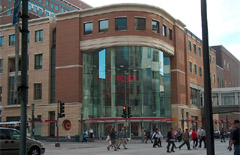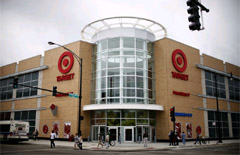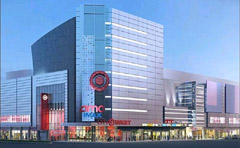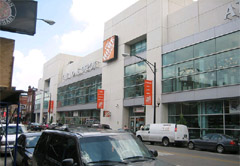Can big box retailers think outside the box? A few years ago the idea of a pedestrian friendly big box store would have been laughable, but as city living becomes more and more popular the major chain retailers are taking note and beginning to build urban format stores.
This post will examine several examples of existing or planned urban big boxes from around the country, including entries from Target, Walmart, and Home Depot, among others.
Of the largest big box retailers, Target seems to be the most progressive with regards to urban design. They were the first to adopt a pedestrian friendly format for new stores, way back in the late 1990s, and seem to have the most examples of urban stores today.
Not to be outdone by its rival, Walmart is getting into the game with proposals for urban stores in New York and Washington, DC. These two renderings come from active (but as yet unbuilt) proposals in Washington:
 H Street proposal. Rendering by Walmart. |  Georgia Avenue proposal. Rendering by Walmart |
Here are some more examples of urban big boxes from around the US:






















This is out of the area of the blogs scope but hopefully Tamarac and University Hospital(if Big Boxes win out) will be this style.
Has anyone in the country assembled a whole bunch of these photos in one place before? I doubt it. Thanks for posting!
Timely discussion. Walmart is also running with their apparently freestanding “Walmart Express” concept to compete with the likes of Dollar Tree. Not urban big box per se, but an important shift either way.
http://seattletimes.nwsource.com/html/businesstechnology/2015228402_walmartexpress04.html
Thanks for the pics. It’s also worth noting Home Depot has an urban store on Chicago’s North side on Clark Street, three stories I believe, and includes parking.
As much as I dislike Wal-Mart, I am interested in seeing their smaller format food stores come to life. If anyone can make a small format grocer work, it would seem to be them.